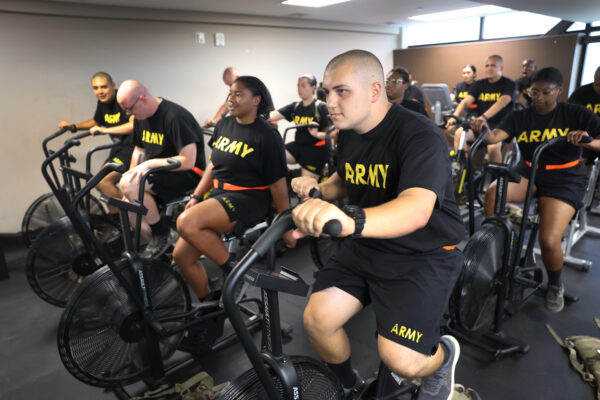
Major hurdle recruiters face is obesity. As of 2020, the prevalence of obesity in the adult population hit nearly 42 percent.
It’s no secret that the U.S. military is struggling to find people who are fit for service these days. Maintaining health and wellness among its existing members has also become a challenge.
A Department of Defense report cited during a Feb. 16 congressional hearing offered a hard pill to swallow: 77 percent of Americans between the ages of 17 and 24 are unqualified physically to enter the armed forces. That’s a 6 percent increase from 2017, which has added to the struggle to find new recruits in every branch of the military.
One of the major hurdles recruiters now face is obesity, which has become a dominant health challenge for Americans. As of 2020, the prevalence of obesity in the adult population hit nearly 42 percent.
In addition, research shows that government food subsidies are a significant contributing factor.
One 2022 study found a link between receiving food assistance and a greater chance of becoming obese through the consumption of unhealthy foods. That’s especially true for participants in the Supplemental Nutrition Assistance Program (SNAP).
As the largest federal nutrition assistance program in the United States, SNAP counts thousands of U.S. military members among its beneficiaries.
Presently, there are 22,000 active duty individuals and nearly 250,000 National Guard service members who receive SNAP, according to the U.S. Department of Agriculture (USDA).
But this isn’t a new problem. Findings from a 2015 USDA analysis revealed that 40 percent of total SNAP participants were obese.
The Cost Barrier
The top seven subsidized foods covered under SNAP have been associated with “cardiometabolic risk factors” such as obesity since 2009. Subsidized crops are turned into highly processed foods with little to no nutritional benefit, many of which are available to SNAP recipients.
Ultra-processed foods directly contribute to obesity, according to a 2022 health report. The analysis states that the consumption of ultra-processed foods is likely much higher among those participating in SNAP.
And that’s because, unlike some U.S. nutrition subsidy programs, SNAP covers items such as cookies, soda, candy, and ice cream.
So participants aren’t only eating higher quantities of heavily processed items, but also have access to a lot of junk food.
Although food assistance is critical for more than 41 million Americans, nutritionists argue that a helping hand shouldn’t be at the expense of someone’s health. And it really comes down to cost. It’s simply cheaper to eat junk than it is to eat healthier food.
“We need a system that reduces the cost of healthy, unprocessed foods and makes it easier for people to afford and access them,” Dana Ellis Hunnes, senior clinical dietitian at UCLA Medical Center, told The Epoch Times.

Hunnes has a passion for nutrition, which she shares in her book “Recipe for Survival.” She noted that ultra-processed food is the cornerstone of federal food assistance, which can fuel high obesity rates.
“Ideally, we should be offering significantly more fruits, vegetables, whole grains, nuts, seeds, legumes, and farmers’ market vouchers than … processed cereals, dairy products, and other packaged ultra-processed foods,” she said.
“People who are using these programs want healthier foods and deserve healthier foods, not cheap surplus commodities.”
But choosing to eat healthily comes with a bigger price tag. That’s especially true as food inflation has hit American wallets hard over the past 12 months.
One Finance Buzz survey of 1,000 U.S. adults revealed that 65 percent of respondents say the cost of eating healthy has either “frequently” or “occasionally” deterred them from eating as healthily as they would like.
Research from Utah State University shows that healthy dietary guideline examples from MyPlate would cost a family of four upward of $14,400 annually. By comparison, the average middle-income family spends an estimated $6,224 on food each year. Low-income families spend even less, at around $3,862 per year.
That translates into fewer healthy eating options and higher obesity rates for those who need food assistance.
A Dangerous Dilemma
In September 2022, a U.S. Army general bluntly said that young Americans are either too obese, too sick, or too criminal to serve in the military.
“Some of the challenges we have are obesity, we have pre-existing medical conditions, we have behavioral health problems, we have criminality, people with felonies, and we have drug use,” Lt. Gen. Xavier Brunson told The Spokesman-Review of Spokane, Washington.
Brunson called it a “condition,” saying that “this is not an Army problem, so nationally what we have to look at is what’s going on with our youth.”
The general’s statement came as a response to difficulties the U.S. military had reaching their target goals for recruits in 2022. This struggle, prevalent in the Army, Navy, Marine Corps, and Air Force, has prompted security analysts and some U.S. institutions to declare obesity a threat to national security.
Obesity a Security Threat
“Each year, more than $60 million goes toward replacing the 1,200-plus first-term enlistees discharged for excess weight,” Irina Tsukerman, a security analyst and the owner of Scarab Rising, told The Epoch Times.
She said high obesity rates have narrowed the recruiting pool considerably, coupled with “falling intelligence and education standards.” She also noted that, along with reduced resiliency and flexibility, the military is less prepared to meet “asymmetrical or conventional challenges.”
Police departments struggle with similar challenges, according to Tsukerman.
“We have also seen the impact of poor fitness and obesity among police forces in urban areas,” she said. “Unfit officers facing high-risk scenarios are less likely to perform well at their jobs … the same can become a dangerous trend on the battlefield.”
The Centers for Disease Control and Prevention (CDC) also classifies America’s obesity challenge as a security threat. The organization estimates that 1 in 5 children and 2 in 5 U.S. adults are now obese.
CDC statistics also show that 19 percent of active-duty service members suffered from obesity in 2020, which is up from 16 percent in 2015.
Active-duty soldiers struggling with obesity are also 33 percent more likely to suffer musculoskeletal injuries.
Lowering the Bar?
In response to this challenge, the U.S. military is adjusting its fitness requirements for some jobs, especially those that aren’t physically demanding, such as technology-based positions.
Tsukerman cautioned that lowering the bar within the U.S. military could set a dangerous precedent.
“While it is true that technical developments such as the use of UAV [unmanned aerial vehicles] and AI [artificial intelligence] have displaced some human participation in the field, much of the combat still relies on conventional human performance,” she said. “Therefore, national security directly depends on human forces being astute, situationally aware, and agile.”
Hunnes said it comes down to getting people on track with proper nutrition right out of the gate. She said healthy breakfast and lunch options for children and better nutrition for pregnant mothers is a good start to tackle obesity issues among today’s youth.
